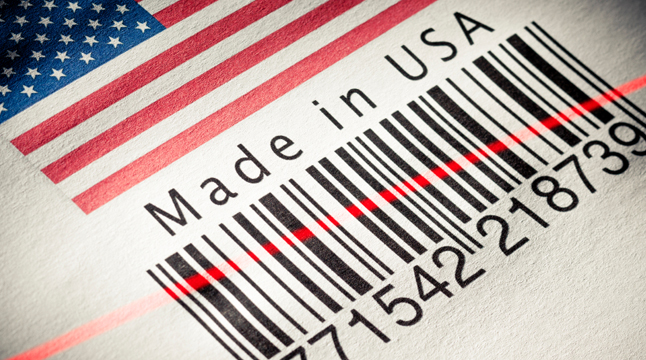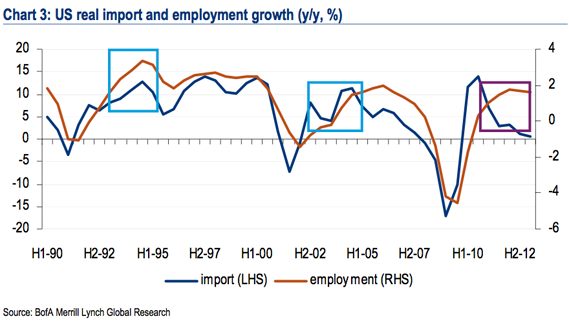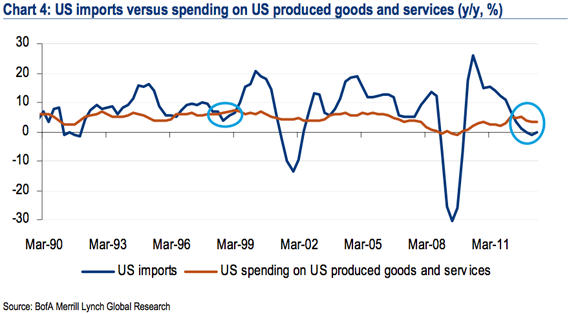Made In The U.S.A. Should Boost The Dollar
U.S. consumers are spending more money on domestic goods and services at the cost of imports, and this trend will likely boost the dollar in the medium term, according to a B. of A. Merrill Lynch Global Research report.
Real import growth has declined to less than 1% in the first half of 2013 from 11% in the first half of 2010, wrote David Woo, head of global rates and currencies research at Bank of America Merrill Lynch. At the same time, employment growth jumped to 1.6% from -1.7%. The divergence in directions of the two growth figures is “unusual,” since an upturn in the business cycle would typically increase both, as shown in the chart below.
So what’s happening? It appears that people in the U.S. are spending more on domestically produced goods and services and less on imports. To get a sense of how striking this is, take a look at the chart below. This is just the second time since 1990, excluding recessions, where spending growth on domestic goods and services is growing faster than imports, Woo said.
And the jump in spending on domestic goods and services has been propelled by some pretty interesting factors. That includes the rise in domestic energy production and the resurgence of U.S. manufacturing, perhaps most notably in the auto industry. The former was helped in part by fracking, said Woo in an interview, while the latter was driven by the U.S. bailout of the auto sector. Another contributing factor is the aging baby boomers,who tend to spend on goods and services that are hard to import. That includes medical care, food services and housing arrangements, Woo said. ”The bottom-line: a move away from imports is favoring domestic labor intensive sectors, creating jobs in the U.S.,” he wrote.
But what does this spending shift, also called import substitution, have to do with the direction of the U.S. dollar? The answer lies in the combination of the external balance, or trade balance, and the internal balance, or unemployment rate. Those two balances, trade balance and unemployment rate, are “the two most fundamental variables for any currency,” said Woo in an interview.
As domestic demand increases, that spending can either focus on domestic or imported goods and services. A focus on domestic goods, as is currently the case, would lead to a decline in the unemployment rate, according to the note.
And here’s the tie-in to the Federal Reserve, which currently keeps interest rates low. The Fed has set an unemployment threshold (not trigger, as officials like to remind us) of 6.5% unemployment for a change in interest rates.
So the shift in spending habits, or import substitution, which is creating jobs and driving the unemployment rate lower, will eventually lead the Fed to hike interest rates and push the dollar higher. “Ultimately, for the dollar to strengthen, we need the Fed to hike rates,” Woo said.
But what does this spending shift, also called import substitution, have to do with the direction of the U.S. dollar? The answer lies in the combination of the external balance, or trade balance, and the internal balance, or unemployment rate. Those two balances, trade balance and unemployment rate, are “the two most fundamental variables for any currency,” said Woo in an interview.
As domestic demand increases, that spending can either focus on domestic or imported goods and services. A focus on domestic goods, as is currently the case, would lead to a decline in the unemployment rate, according to the note.
And here’s the tie-in to the Federal Reserve, which currently keeps interest rates low. The Fed has set an unemployment threshold (not trigger, as officials like to remind us) of 6.5% unemployment for a change in interest rates.
So the shift in spending habits, or import substitution, which is creating jobs and driving the unemployment rate lower, will eventually lead the Fed to hike interest rates and push the dollar higher. “Ultimately, for the dollar to strengthen, we need the Fed to hike rates,” Woo said.
The bank has 2014 year-end forecasts of the euro fetching $1.22 and the dollar buying 108 Japanese yen.
SOURCE: Market Watch






Leave a Reply
Want to join the discussion?Feel free to contribute!